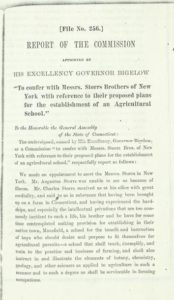By Michael Rodriguez
When the University of Connecticut started life as the Storrs Agricultural School in 1881, Governor Hobart Bigelow appointed its first eight trustees. Since then, Connecticut’s sitting governor has traditionally served as the Board’s nominal president. Reflecting 19th-century Connecticut’s priorities and power imbalances, UConn’s first trustees were all prosperous, influential white men with roots in agriculture.
Like the State of Connecticut, UConn’s Board of Trustees has gradually shifted away from its agricultural background. The trustees are responsible for keeping the university accountable to the public and guiding UConn’s strategic directions. Trustees approve major investments, advocate with public officials and donors, and hire and fire presidents. Trustees at any university are typically powerful politicians, business executives, or distinguished alumni. Board membership reflects what Connecticut’s governors—and by extension, the voters—feel should be UConn’s priorities. In 1881, nearly all of UConn’s trustees were closely connected to agriculture and the state’s farming community. Most were farmers or agronomists in their own right; others sold agricultural supplies or represented nearby communities. In contrast, virtually none of UConn’s 21st-century trustees have a direct connection to agriculture. Today, the first trustees of UConn would probably not recognize their institution and its changed priorities.
Meet UConn’s First Trustees
John P. Barstow (served 1881–1889), proprietor of J. P. Barstow & Co., was a wealthy merchant based in Norwich, specializing in agricultural tools and supplies. Starting in 1881, he served on the state Board of Agriculture. As a trustee, Barstow was UConn’s Board treasurer and, along with Ephraim Hyde and Oscar Vinton, oversaw repairs and renovations to the campus buildings in 1881.
Theodore Sedgwick Gold (served 1881–1900) served as Board secretary for nearly 20 years. A West Cornwall farmer-educator, he had been secretary of the state Board of Agriculture since 1866 and was a strong advocate for the formation of the Storrs Agricultural School. Along with Samuel W. Johnson and James B. Olcott, Gold organized the school and its curriculum.
John Manning Hall (served 1881–1882) was Windham County’s star lawyer. A Yale graduate and Willimantic native, Hall was serving his fourth term in the General Assembly when the governor appointed him a trustee. He became speaker of the house in 1882. At the height of his career, Hall served as a superior court judge and president of the New York, New Haven, and Hartford Railway Company.
Josiah Meigs Hubbard (served 1881–1896) was a rich farmer from one of the leading families of Middletown. He represented Middletown for many years in the General Assembly. In 1891, the New York Times described him as a “recognized leader of the farming class of the State.”
Ephraim H. Hyde (served 1881–1899) of Stafford served as Connecticut’s lieutenant governor (1867–69) and president pro tempore of the state Senate (1876–77). He bred award-winning Devon cattle and had long advocated for an agricultural school in northeastern Connecticut.
Samuel William Johnson (served 1881–1889) was a professor of agricultural chemistry at Yale University and director of the Connecticut Agricultural Experiment Station from 1877 to 1899. With Gold and Olcott, he helped organize the school and recruited its first faculty members.
James Bradford Olcott (served 1881–1888) was a South Manchester farmer and landscaper for the silk mills-owning Cheney Brothers. Olcott served on a three-person committee that enabled UConn’s existence by advising the General Assembly that an agricultural school in Storrs was a viable proposition. Olcott later helped Gold and Johnson design the school’s curriculum.
Simeon Oscar Vinton (served 1881–1882) worked as postmaster and stationmaster in Eagleville, two miles from UConn. He also kept a store in Eagleville and served in the General Assembly. His daughter-in-law, Annie L. Vinton, became one of UConn’s first female trustees in 1922.
UConn’s Shift in Board Makeup
For decades, UConn—along with the state of Connecticut—has moved away from practical agriculture and toward research, entrepreneurship, and the financial industry. The choice of trustees reflects this change in focus, as they are increasingly drawn from big business. The result is a university that has continued to reflect the needs of the state, as the priorities of UConn and Connecticut have evolved together.
Michael Rodriguez is Collections Strategist at the University of Connecticut Library and has contributed more than eighty articles on Connecticut history to Wikipedia.










